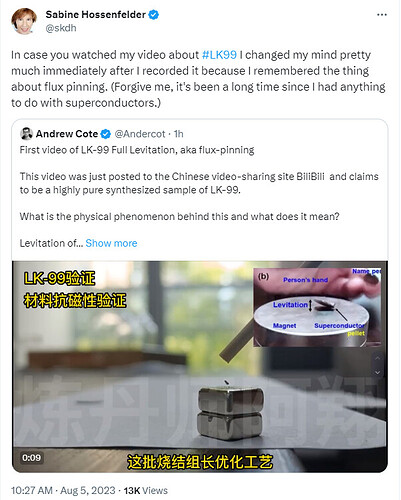I was thinking that a 100% effective cure for cancer is probably not the best for our society, so a 60% uptake sounds like a good thing.
About ten years ago I went to a friend’s physics dissertation defense, which her advisor started with an announcement that he’d just learned of a cure for lung cancer. I think about that every time I read something like this. But still…
Couple of updates. The Lab that released the first apparently successful LK-99 replication video released a preprint:
Conclusion says this:
We have successfully grown the LK-99 materials with consistent diamagnetism transition and large levitation angle at room temperature and ambient pressure. Our results show the importance of crystallinity and proper Cu doping, indicating the fundamental potential superconducting mechanism with copper-oxygen induced band changes in such phosphate oxides. We expect more consistent tests such as electrical tests in room temperature will show the great potential [in/of] such phosphate oxides
Secondly, Andrew McCalip (space capsule engineer out of California that’s been live streaming his replication efforts) uploaded a video demonstrating levitation in his first batch of LK-99.
https://twitter.com/andrewmccalip/status/1687405505604734978
That’s the video. Has some good close ups of behaviour. Like all the others it seems to stand on one end rather than fully levitate.
He has 7 more batches but thinks two might be damaged.
I feel like the Russian in Armageddon that pulled the straw and said something like
“Is this good or bad”
Koreans have sent their paper to APL, looks like we wait a few weeks for review. idk why they didn’t send something this huge to Nature Materials or whatever, seems odd. The Russian catgirl seems to think it could be some kind of quasi-superconductor.
https://twitter.com/floates0x/status/1687296154416066560?s=20
https://twitter.com/iris_IGB/status/1687367290566656000?s=20
There have been five Nobel prizes awarded for work on superconductivity. This could lead to number six. The pressure on Kim et al. must be enormous.
Looking into microprocessor power consumption a little more, interconnects account for ~50%. That’s a lot more than I would have guessed, so a SC material would be useful. Unfortunately, LK-99 wouldn’t work. It isn’t compatible because lead atoms have high mobility in silicon. Diffusion of lead into the bulk of the semiconductor would change it’s properties. So we’re stuck with aluminum for now.
Maybe they can engineer a diffusion barrier? Lots of semiconductor people are pretty handy at that sort of thing.
They are creative. Maybe keep Al for contacts then deposit interconnects on top, extending over SiO2. But there’s also an issue with how this material is formed vs how metals are typically deposited on a wafer (e-gun, sputtering, CVD).
I would ignore this person. They studied at colleges that suck
Sabine just tweeted this. She seems to be quite interested by the below as yet unverified video.
Cote’s current thinking.
My evolving mental model currently is that this material may have one-dimensional superconducting pathways that exist between the overlapping copper and oxygen orbitals inside the doped lead-apatite crystal lattice.
A solid chunk of this material would contain many small crystal domains each with a coherent orientation, along with grain boundaries between them that create disruptions in the conduction pathways.
So, any bulk measurement of resistance ends up including both the superconducting paths as well as the non-superconducting resistive pathways between adjacent crystal grains.
Think of it as a series of short highways that are connected by smaller roads with a much lower speed limit. If you measure the ‘average speed’ across a large route, you see it is much lower than what the speed of the highways is, because it includes all the much-slower intermediate roads that connect the highways.
Is that good or bad?
Seems mostly good. Probably need to be able to control sample preparation more precisely and science the shit out of it. Material deposition systems typically used in semiconductor manufacturing could be useful. People might need to get interdisciplinary. They probably are already. “Hey, I want to use your sputtering system.”
Edit: Thinking a little more about semiconductor stuff. I checked the temperatures given in the LK-99 preparation section of the original paper, and 950 C is the highest needed. This is not a problem for semiconductor fabrication. So maybe this material is compatible. 
Otoh, for microprocessors, the priority wouldn’t be to run them cooler. They would juice the power/performance so your laptops would be just as hot as before.
Nature has picked up the story:
Ya boi is back, things got scary there but Voyager 2 is still alive. 46 years old, still on its grind, absolutely mindblowing human achievement.
https://twitter.com/NASAVoyager/status/1687549375445352449?s=20
No idea, but he still sounds enthusiastic. Sounds like something to work on maybe?


